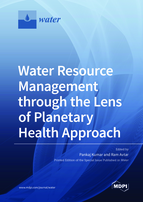Water Resource Management through the Lens of Planetary Health Approach
A special issue of Water (ISSN 2073-4441). This special issue belongs to the section "Water Resources Management, Policy and Governance".
Deadline for manuscript submissions: closed (25 April 2022) | Viewed by 34829
Special Issue Editors
Interests: hydrological modeling; urban water management; wastewater management; sustainable development goals
Special Issues, Collections and Topics in MDPI journals
Interests: UAV; earth observation and forestry
Special Issues, Collections and Topics in MDPI journals
Special Issue Information
Dear Colleagues,
Since the beginning of time, water resources have been the key to inclusive social development and human wellbeing. However, spatiotemporal variation of this finite resource over various landscapes makes it prone to misuse and mismanagement. Rapid global changes such as urbanization, population growth, socioeconomic change, changes in lifestyle, evolving energy needs, and climate change have put unprecedented pressure on this finite freshwater resource. Keeping this in mind, it is argued that achieving water security throughout the world is the key to achieving sustainable development in a comprehensive manner. However, scientific studies with a holistic point of view, considering persistently changing dimensions, are still in their embryonic stage. Broadly, water security evolves from ensuring reliable access to enough safe water for every person (at an affordable price where market mechanisms are involved) to lead a healthy and productive life, including future generations. Additionally, there is a need to transition from water scarcity toward water security for a water-secure present and future. This transition requires a look at this complex issues and interdependencies between water, environment, human health, and governance/institutions, with more inclusive regulations at the forefront. Despite recent progress in developing new strategies, practices, and technologies for water resources management, their dissemination and implementation have been limited. The nexus approach encompasses these interdependencies.
Considering the abovementioned information gap, this Special Issue strives to capture the persistently changing dimensions and new paradigms of water security, providing a holistic view, including a wide range of sustainable solutions to address water security. It will discuss gaps, opportunities and challenges, and lessons learned from past experiences for achieving water security at any particular landscape. It will highlight how recent scientific innovations in research methodologies, including the planetary health approach, water–food–energy–health–biodiversity nexus, urban–rural nexus, regional–circular–ecological–sphere approach, etc. have contributed significantly to resolve this complex issue of water security. Finally, a topic to be discussed is what the way forward is for a better science–policy interface through the inclusion of every relevant stakeholder with codesign and codelivery of various adaptation and mitigation strategies needed to achieve global goals, e.g., SDGs at a local level in a timely manner.
We welcome contributions dealing with, but not limited to the following topics:
- Scenario-based hydrological simulation;
- Use of an integrated approach to assess water environment (remote sensing, GIS, statistical analysis, participatory approach, field analysis, etc.);
- Nexus approach to evaluate the interaction between human wellbeing and water systems.
Dr. Pankaj Kumar
Dr. Ram Avtar
Guest Editors
Manuscript Submission Information
Manuscripts should be submitted online at www.mdpi.com by registering and logging in to this website. Once you are registered, click here to go to the submission form. Manuscripts can be submitted until the deadline. All submissions that pass pre-check are peer-reviewed. Accepted papers will be published continuously in the journal (as soon as accepted) and will be listed together on the special issue website. Research articles, review articles as well as short communications are invited. For planned papers, a title and short abstract (about 100 words) can be sent to the Editorial Office for announcement on this website.
Submitted manuscripts should not have been published previously, nor be under consideration for publication elsewhere (except conference proceedings papers). All manuscripts are thoroughly refereed through a single-blind peer-review process. A guide for authors and other relevant information for submission of manuscripts is available on the Instructions for Authors page. Water is an international peer-reviewed open access semimonthly journal published by MDPI.
Please visit the Instructions for Authors page before submitting a manuscript. The Article Processing Charge (APC) for publication in this open access journal is 2600 CHF (Swiss Francs). Submitted papers should be well formatted and use good English. Authors may use MDPI's English editing service prior to publication or during author revisions.
Keywords
- planetary health
- water-food-energy-health nexus
- transdisciplinary research
- water resource management
- water security
- SDG 6.0
- hydrological simulation
- remote sensing and GIS
- water quality







